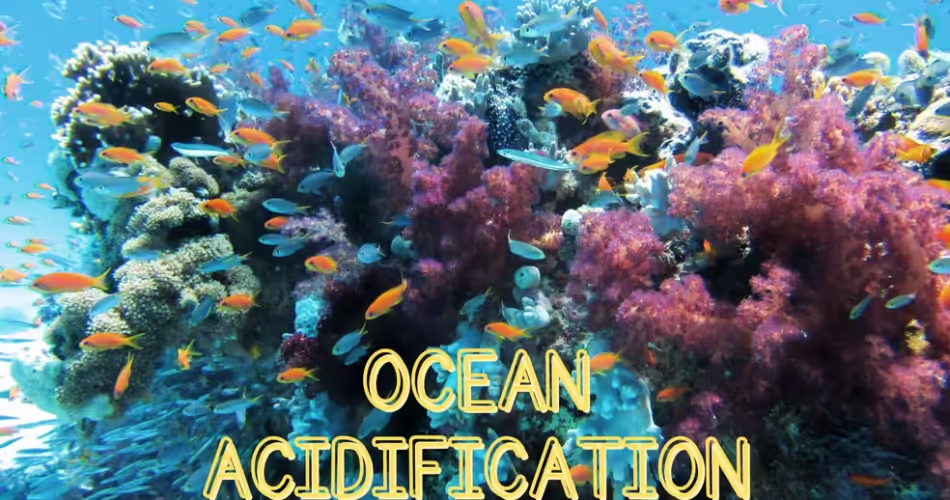This blog will provide you information about rising problem about Ocean Acidification. At first, we will discuss what is Acidification and characteristics of Acidification. Then we will discuss the potential Causes of Ocean acidification. After that we will discuss the Solutions of Ocean Acidification. At the end we will discuss the Effects of Ocean Acidification on Aquatic Environment and species. This blog will explain ocean acidification, its causes, equation, effects and solutions.
1: Acidification:
Acidification is the process in which an aquatic ecosystem becomes acidic than usual. It can the decrease in pH of the water body either it is a lake, sea, ocean or a pond. Acidification have adverse impacts on aquatic composition and disturb the lives of aquatic ecosystem.
Characteristics of Acidification:
Acidification causes increased concentrations of H+ ions.
This cause metal compounds to ionize into the water and add heavy metals in aquatic ecosystem.
It decreases the pH of the water body.
This is dangerous for sensitive ecosystems in water i.e. Coral Reefs.
It decreases the oxygen concentration for the living organisms in water.
2: What is Ocean Acidification?
Ocean acidification is the process by which the ocean absorbs carbon dioxide from the atmosphere, thus decreasing the ocean’s pH
•The ocean absorbs up to one-third of the carbon dioxide CO2 in the earth’s atmosphere
•Ocean acidification is the slow process that happens over a long time. It can take years for the ocean to become acidic.
•Carbon dioxide has been building up in the atmosphere for a long time, which has made the oceans more acidic.
•Ocean water has a pH of around 8.1.
•A lot of research shows that the ocean is 30% more acidic then it was 200 years ago.

2: Causes of Ocean Acidification:
Ocean acidification is mainly caused by carbon dioxide gas in the atmosphere dissolving into the ocean. This leads to a lowering of the water’s pH, making the ocean more acidic. Many factors contribute to rising carbon dioxide levels. Currently, the burning of fossil fuels such as coal, oil and gas for human industry is one of the major causes.
• Acid Rain:
Acid rain is the condensation of toxic air pollutants in the form of rain and coming to the land. This is the direct source of adding acids to the ocean and other water resources. Other water resources and acidic runoffs, adds into the ocean at the end causing increase in ocean acidification.
•Fossil Fuel Combustion:
As we know that, after the start of industrial era, fossil fuel combustion is very common. It adds toxic air pollutants including CO2 to the environment in large quantities. This contributes in the CO2 production and is added to the ocean increasing its acidity.
•Human Respiration:
Human respiration include inhalation of oxygen from the environment and exhalation of CO2. This factor also adds to the increase in concentration of CO2 in the atmosphere, that is eventually absorbed into the ocean.
•Decomposition of dead matter:
Decomposition of organic matter is the natural cause of ocean acidification. If this decomposition occurs on land, it cause CO2 addition into the air and when this decomposition occurs in the water, it is the direct addition of CO2 in the ocean water.
•Deforestation:
Forests are the major source of oxygen and major sink of CO2. When we cut forests the oxygen levels becomes less and CO2 levels becomes greater in the environment. Deforestation results in fewer trees to absorb the gas. Also, when plants are cut down and burnt or left to rot, the carbon that makes up their organic tissue is released as carbon dioxide. So, deforestation is one of the major cause of enhances concentrations of CO2 in the air and in the ocean.
All of these are main causes of ocean acidification. This blog contains causes, solutions, effects of ocean acidification.
3: Equation behind Ocean Acidification:
Carbonate ions are an important building block of structures such as sea shells and coral skeletons. Decreases in carbonate ions can make building and maintaining shells and other calcium carbonate structures difficult for calcifying organisms such as oysters, clams, sea urchins, shallow water corals, deep sea corals, and calcareous plankton.
4: Solutions for Ocean Acidification:
1.To Control GHG Emissions:
Green House Gases (GHGs) are produced by fossil fuel combustion on industrial scale and in household activities. The control of GHG emissions will reduce the acidity added to the water and thus decrease ocean acidification in the ocean water. CO2 is the most important cause of ocean acidification.
2.To keep our Beaches Clean:
Plastic wastes that reach our beaches when adds to ocean water, it is the cause of acidity of ocean water. When the plastic wastes adds into the ocean water, they release microplastics, acids and chemicals in the water. So, if we will keep our beaches clean, we can get rid of plastic waste addition in the ocean.
3.To increase no. of useful species:
We should increase the number of species that use carbon dioxide as the source of energy. These organisms will absorb CO2 and take it to the deep sea which is carbon sink so these animals and plants will act as the restoration of ocean acidification within the ocean.
Role of Animals:
1. Microscopic plants sequester vast amounts of carbon dioxide.
2. They are able to ‘fix’ nearly one-fifth of global carbon.
3. The erosion of marine plants may be contributing to a growth in emissions.
4. Whales work together with plankton to further store and reduce carbon.
4.Avoid use of fertilizers and pesticides:
To avoid ocean acidification we should avoid or control the use of fertilizers and pesticides so that no polluted runoff reach the ocean directly. Fertilizers and pesticide comprises of most of the acidic materials into the water resources every year so we should reduce or avoid the use of pesticides and fertilizers.
5.Effects of Ocean Acidification:
Following are few effects of ocean acidification:
Ocean acidification cause increase the concentration of Hydrogen H+ ions.
It decreases the pH of ocean water.
Ocean Acidification destroys the carbonic acid molecules so as that are building block of the ocean.
It disturbs the natural chemical composition of ocean water.
This adds acidic substances in the food chains and the people consuming aquatic animals from acidic environments.
All of these effects have adverse impacts on the aquatic life at a great extent.
6: Conclusion
Ocean Acidification is considered as a rising issue for humans, animals and aquatic animals. Because of this the composition of the ocean is also disturbed and eventually disturbs the life of aquatic animals. Rising levels of CO2 is the major driver for this acidification because ocean acts as a natural carbon sink and all the extra carbon present in the environment is eventually stored in the ocean. We should control ocean acidification by controlling GHG emissions, by increasing number of carbon absorbing species and by reducing the use of chemical fertilizers and pesticides. By reducing GHGs emissions we can reduce acidification in our water resources thus reducing ocean acidification. This blog contains causes, solutions, effects of ocean acidification.

To learn about more topics, click the link below:


Comments